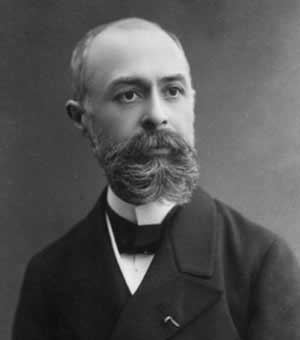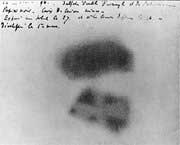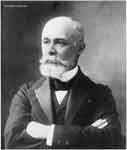.
Henri Becquerel

Henri Becquerel
Antoine Henri Becquerel (December 15, 1852 August 25, 1908) was a French physicist, Nobel laureate, and one of the discoverers of radioactivity.
Becquerel was born in Paris into a scientific family which, including him and his son, produced four generations of scientists. He studied science at the École Polytechnique and engineering at the École des Ponts et Chaussées. In 1892 he became the third in his family to occupy the physics chair at the Muséum National d'Histoire Naturelle. In 1894 he became chief engineer in the Department of Bridges and Highways.

Image of Becquerel's photographic plate which has been fogged by exposure to radiation from uranium salts. The shadow of a metal Maltese Cross placed between the plate and the uranium salts is clearly visible.
In 1896, Becquerel accidentally discovered radioactivity while investigating phosphorescence in uranium salts. Investigating the work of Wilhelm Conrad Röntgen, Becquerel wrapped a fluorescent mineral, potassium uranyl sulfate, in photographic plates and black material in preparation for an experiment requiring bright sunlight. However, prior to actually performing the experiment, Becquerel found that the photographic plates were fully exposed. This discovery led Becquerel to investigate the spontaneous emission of nuclear radiation. In 1903 he shared the Nobel Prize in Physics with Pierre and Marie Curie "in recognition of the extraordinary services he has rendered by his discovery of spontaneous radioactivity".
Describing his method to the French Academy of Sciences on January 24, 1896, he said,
One wraps a Lumière photographic plate with a bromide emulsion in two sheets of very thick black paper, such that the plate does not become clouded upon being exposed to the sun for a day. One places on the sheet of paper, on the outside, a slab of the phosphorescent substance, and one exposes the whole to the sun for several hours. When one then develops the photographic plate, one recognizes that the silhouette of the phosphorescent substance appears in black on the negative. If one places between the phosphorescent substance and the paper a piece of money or a metal screen pierced with a cut-out design, one sees the image of these objects appear on the negative. … One must conclude from these experiments that the phosphorescent substance in question emits rays which pass through the opaque paper and reduces silver salts.[1]
Final days and legacy
In 1908, the year of his death, he was elected permanent secretary of the Académie des Sciences. He died at the age of 55 in Le Croisic.
The SI unit for radioactivity, the becquerel (Bq) is named after him, and also there are Becquerel craters on the Moon and Mars.
- Rumford Medal (1900)
- Helmholtz Medal (1901)
- Nobel Prize for Physics (1903)
- Barnard Medal (1905)
See also
- A. E. Becquerel (his father)
- Antoine César Becquerel (his grandfather)
- Jean Becquerel (his son)
References
- ^ Comptes Rendus 122, 420 (1896), translated by Carmen Giunta. Accessed September 10, 2006.
Links
- Henri Becquerel - Biography
- About Henri Becquerel
- Becquerel short biography and the use of his name as an unit of measure in the SI
Retrieved from "http://en.wikipedia.org/"
All text is available under the terms of the GNU Free Documentation License


